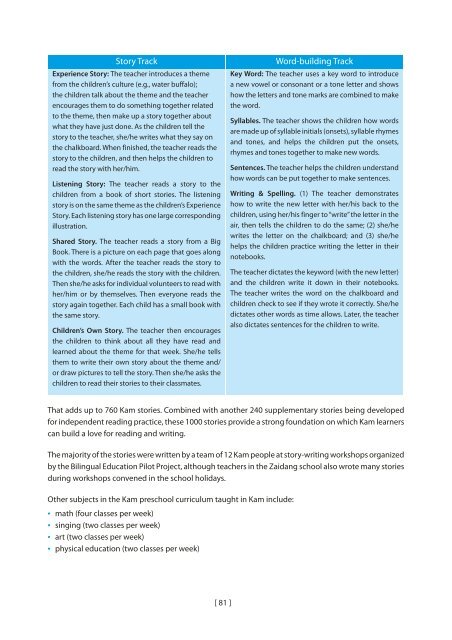Mother Tongue-based Literacy Programmes: Case Studies of Good ...
Mother Tongue-based Literacy Programmes: Case Studies of Good ...
Mother Tongue-based Literacy Programmes: Case Studies of Good ...
You also want an ePaper? Increase the reach of your titles
YUMPU automatically turns print PDFs into web optimized ePapers that Google loves.
Story TrackExperience Story: The teacher introduces a themefrom the children’s culture (e.g., water buffalo);the children talk about the theme and the teacherencourages them to do something together relatedto the theme, then make up a story together aboutwhat they have just done. As the children tell thestory to the teacher, she/he writes what they say onthe chalkboard. When finished, the teacher reads thestory to the children, and then helps the children toread the story with her/him.Listening Story: The teacher reads a story to thechildren from a book <strong>of</strong> short stories. The listeningstory is on the same theme as the children’s ExperienceStory. Each listening story has one large correspondingillustration.Shared Story. The teacher reads a story from a BigBook. There is a picture on each page that goes alongwith the words. After the teacher reads the story tothe children, she/he reads the story with the children.Then she/he asks for individual volunteers to read withher/him or by themselves. Then everyone reads thestory again together. Each child has a small book withthe same story.Children’s Own Story. The teacher then encouragesthe children to think about all they have read andlearned about the theme for that week. She/he tellsthem to write their own story about the theme and/or draw pictures to tell the story. Then she/he asks thechildren to read their stories to their classmates.Word-building TrackKey Word: The teacher uses a key word to introducea new vowel or consonant or a tone letter and showshow the letters and tone marks are combined to makethe word.Syllables. The teacher shows the children how wordsare made up <strong>of</strong> syllable initials (onsets), syllable rhymesand tones, and helps the children put the onsets,rhymes and tones together to make new words.Sentences. The teacher helps the children understandhow words can be put together to make sentences.Writing & Spelling. (1) The teacher demonstrateshow to write the new letter with her/his back to thechildren, using her/his finger to “write” the letter in theair, then tells the children to do the same; (2) she/hewrites the letter on the chalkboard; and (3) she/hehelps the children practice writing the letter in theirnotebooks.The teacher dictates the keyword (with the new letter)and the children write it down in their notebooks.The teacher writes the word on the chalkboard andchildren check to see if they wrote it correctly. She/hedictates other words as time allows. Later, the teacheralso dictates sentences for the children to write.That adds up to 760 Kam stories. Combined with another 240 supplementary stories being developedfor independent reading practice, these 1000 stories provide a strong foundation on which Kam learnerscan build a love for reading and writing.The majority <strong>of</strong> the stories were written by a team <strong>of</strong> 12 Kam people at story-writing workshops organizedby the Bilingual Education Pilot Project, although teachers in the Zaidang school also wrote many storiesduring workshops convened in the school holidays.Other subjects in the Kam preschool curriculum taught in Kam include:••••math (four classes per week)singing (two classes per week)art (two classes per week)physical education (two classes per week)[ 81 ]

















